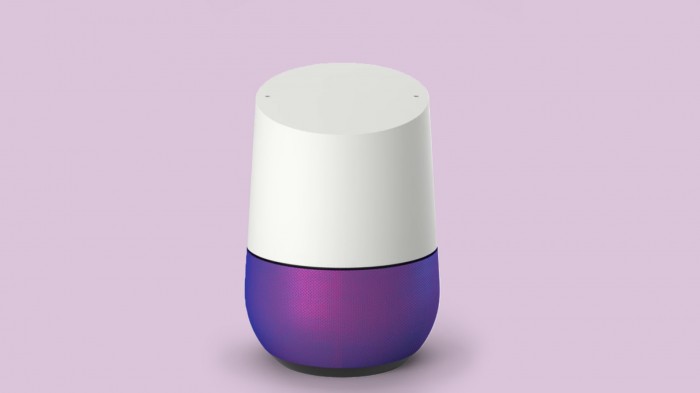Google’s New Home Helper Flexes Powerful AI Muscles
Google didn’t change much when it ripped off Amazon’s idea of making a compact home speaker with a voice-activated assistant inside.
Just like Amazon’s Echo, Google Home, released today, has microphones tuned to hear from across the room. Both devices can be asked to cue up music on Spotify and other services, set alarms and timers, and pose factual queries. And both companies say their devices will gain powers as other companies integrate their services, letting you do things like order takeout from your couch.
But Google has a crucial advantage in the race to prove out that idea. It’s been working on technology that answers people’s questions for a long time, and has invested more heavily in machine learning than its rivals.

Early reviews suggest that advantage is already apparent. People who compared Echo, and its Alexa assistant, with Google Home found the latter to be significantly better at understanding language and answering questions.
The New York Times’ reviewer describes Google Home as “preternaturally smarter.” The Verge’s sums it up like this: “Home has something that the Echo doesn’t: a wealth of knowledge about the world, my personal preferences, and my habits.”
That doesn’t mean Google is about to prove the thesis that an intelligent speaker can become a universal helper and companion.
Like Echo, Google Home performs well at only certain things, like controlling music. It doesn’t plug into many other devices or services yet. And just like Amazon’s product, it is limited by being tied to a single account and unable to recognize individuals, preventing customized responses that draw on a person’s other data.
Google’s determination to make its assistant the future of search on mobile, too, and its investments in machine learning give it a better shot at solving those limitations. And Amazon knows it. The company is investing in machine learning research and is even considering unusual ideas such as giving Alexa the ability to recognize emotions.
The contest between the two companies—perhaps to be joined by Apple—could produce a much needed jump in the power of virtual assistants. They have become much more polished since Siri was first launched in 2009, but have yet to attain the power and flexibility needed to make them a dominant way to interact with computers.
(Read more: “10 Breakthrough Technologies 2016: Conversational Interfaces,” “Amazon Working to Make Alexa Recognize Your Emotions,” “Assistant Could End Up Eating Google’s Lunch,”)
Keep Reading
Most Popular
Large language models can do jaw-dropping things. But nobody knows exactly why.
And that's a problem. Figuring it out is one of the biggest scientific puzzles of our time and a crucial step towards controlling more powerful future models.
How scientists traced a mysterious covid case back to six toilets
When wastewater surveillance turns into a hunt for a single infected individual, the ethics get tricky.
The problem with plug-in hybrids? Their drivers.
Plug-in hybrids are often sold as a transition to EVs, but new data from Europe shows we’re still underestimating the emissions they produce.
Stay connected
Get the latest updates from
MIT Technology Review
Discover special offers, top stories, upcoming events, and more.